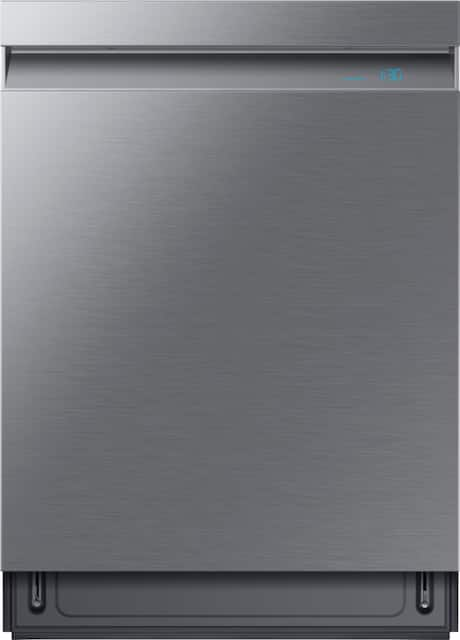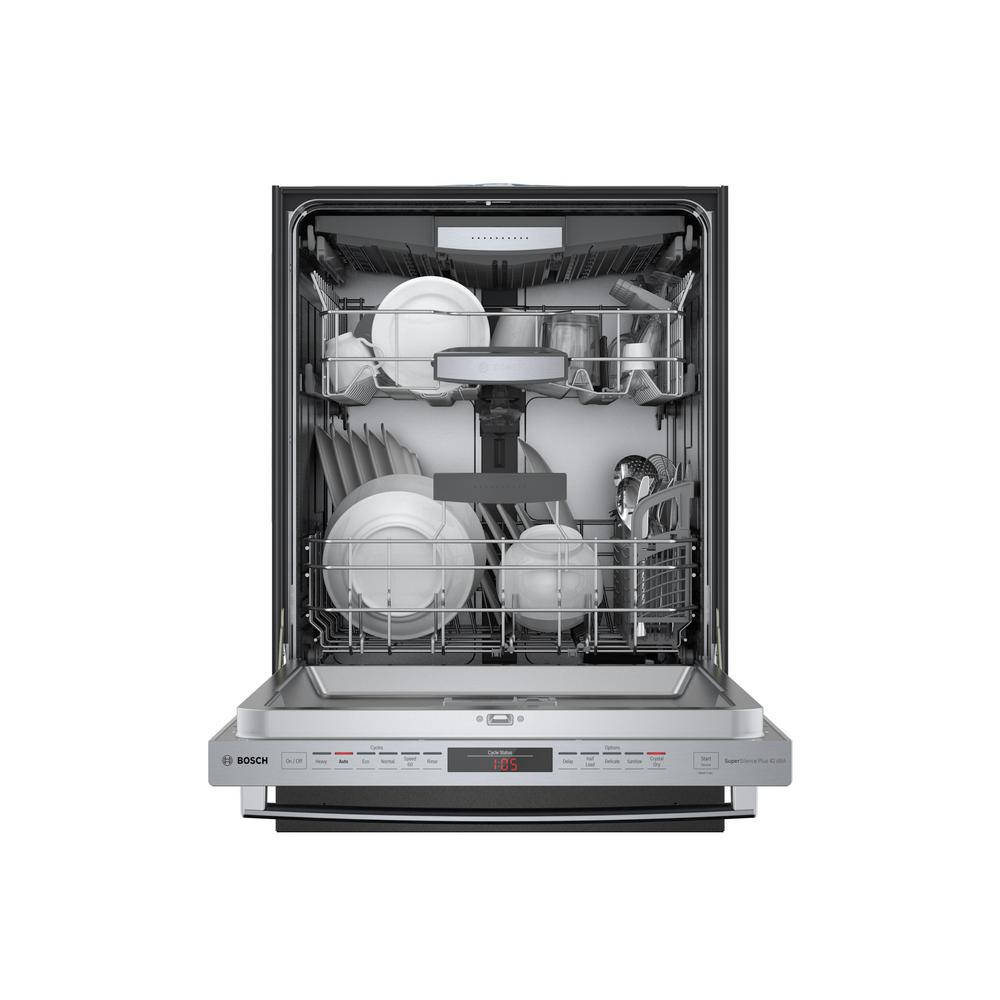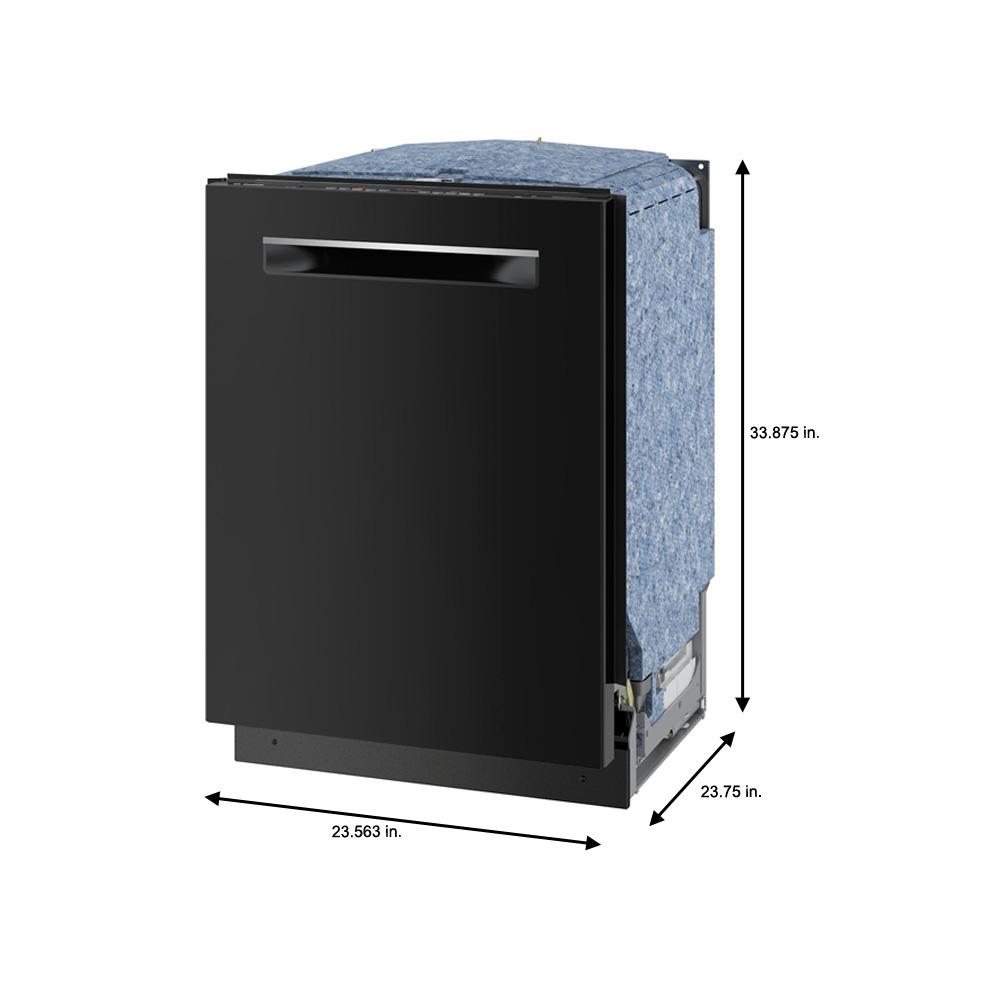Beko DIN16430 Fully Integrated Standard Dishwasher – Stainless Steel / Black Control Panel with Fixed Door Fixing Kit
14 place settings – great for medium-sized households. 30 minute quick wash – great if you’re in a hurry. Flexible baskets make it easy to load larger items. Dries efficiently with heat created during the wash.
This integrated dishwasher from Beko makes the after-dinner clean up a breeze. It holds up to 14 place settings, so it’s ideal for a medium-sized household. Thanks to the clever Auto programme, you’ll only ever use the exact amount of energy that’s needed. It uses sensors to check the level of dirt in the water, so will adjust the cycle to match. You’ll easily be able to fit in any bulky items too, as the flexible baskets can be moved to make room. This model also uses the residual heat from the wash to dry your dishes naturally, meaning you can leave the tea towel in the drawer.
- 14 place settings – great for medium-sized households
- 30 minute quick wash – great if you’re in a hurry
- Flexible baskets make it easy to load larger items
- Dries efficiently with heat created during the wash
- Dimensions (cm) – H81.8 x W59.8 x D55
Less time waiting to unload
Sometimes you’re in a hurry to get a load cleaned, and the quick wash programmes will be a big help. The Mini 30° programme will wash a full load of lightly dirty dishes in just 30 minutes. Or, if you need a more intense wash, the Quick&Shine™ setting will take just 58 minutes to get a full load sparkling again.
No wasted time or energy
Beko’s auto programme gives you the most efficient wash possible, every time. Once the special built-in sensors have measured how dirty your dishes are, they’ll automatically adjust the water and temperature settings to suit. This is not only bound to lighten your monthly bills, but you’ll rest easy knowing you’re doing your bit for the planet too.
Get the dishes done from the comfort of your couch
Cut down on wash times with the handy Fast+ Function. When you choose this setting, it reduces your chosen programme by up to 70% by increasing the water pressure. This means your dishes come out sparkling and you won’t have to wait as long before setting the table.
Know exactly when the dishes are done
With this model, tracking your dishwasher’s progress will be easier than ever. That’s because it’s got a nifty red light that is projected onto the floor when it’s still working, and turns off when your dishes are done. No more opening your dishwasher to a face full of hot steam – perfect.
Tips for measuring up
Want to make sure this integrated dishwasher will fit in your kitchen? Check out our handy measurement guide video. We’ll show you everything you need to know about measuring up in just a few simple steps, so your new appliance will fit like a glove.
Additional information
| Dimensions (cm) | (H)81.8 x (W)59.8 x (D)55.0 |
|---|---|
| Dimensions With Packaging | (H)85.9 x (W)64.4 x (D)66.1 cm |
| Weight | 36 Kg |
Beko ( BEK-oh; stylized as beko) is a Turkish white goods and electronics brand of Arçelik A.Ş., which is controlled by the Koç Holding conglomerate.
Black is a color that results from the absence or complete absorption of visible light. It is an achromatic color, without hue, like white and grey. It is often used symbolically or figuratively to represent darkness. In Western society, black and white have often been used to describe opposites such as good and evil, the Dark Ages versus Age of Enlightenment, and night versus day. In Western society, since the Middle Ages, black has been the symbolic color of solemnity and authority, and for this reason it is still commonly worn by judges and magistrates.
Black was one of the first colors used by artists in Neolithic cave paintings. It was used in ancient Egypt and Greece as the color of the underworld. In Ancient Egypt, black had positive associations; being the color of fertility and the rich black soil flooded by the Nile. In the Roman Empire, it became the color of mourning, and over the centuries it was frequently associated with death, evil, witches, and magic. In the 14th century, it was worn by royalty, clergy, judges, and government officials in much of Europe. It became the color worn by English romantic poets, businessmen and statesmen in the 19th century, and a high fashion color in the 20th century. According to surveys in Europe and North America, it is the color most commonly associated with mourning, the end, secrets, magic, force, violence, fear, evil, and elegance.
Black is the most common ink color used for printing books, newspapers and documents, as it provides the highest contrast with white paper and thus is the easiest color to read. Similarly, black text on a white screen is the most common format used on computer screens. As of September 2019, the darkest material is made by MIT engineers from vertically aligned carbon nanotubes.
A dishwasher is a machine that is used to clean dishware, cookware, and cutlery automatically. Unlike manual dishwashing, which relies on physical scrubbing to remove soiling, the mechanical dishwasher cleans by spraying hot water, typically between 45 and 75 °C (110 and 170 °F), at the dishes, with lower temperatures of water used for delicate items.
A mix of water and dishwasher detergent is pumped to one or more rotating sprayers, cleaning the dishes with the cleaning mixture. The mixture is recirculated to save water and energy. Often there is a pre-rinse, which may or may not include detergent, and the water is then drained. This is followed by the main wash with fresh water and detergent. Once the wash is finished, the water is drained; more hot water enters the tub by means of an electromechanical solenoid valve, and the rinse cycle(s) begin. After the rinse process finishes, the water is drained again and the dishes are dried using one of several drying methods. Typically a rinse-aid, a chemical to reduce the surface tension of the water, is used to reduce water spots from hard water or other reasons.
In addition to domestic units, industrial dishwashers are available for use in commercial establishments such as hotels and restaurants, where many dishes must be cleaned. Washing is conducted with temperatures of 65–71 °C (149–160 °F) and sanitation is achieved by either the use of a booster heater that will provide an 82 °C (180 °F) "final rinse" temperature or through the use of a chemical sanitizer.
A door is a hinged or otherwise movable barrier that allows ingress (entry) into and egress (exit) from an enclosure. The created opening in the wall is a doorway or portal. A door's essential and primary purpose is to provide security by controlling access to the doorway (portal). Conventionally, it is a panel that fits into the doorway of a building, room, or vehicle. Doors are generally made of a material suited to the door's task. They are commonly attached by hinges, but can move by other means, such as slides or counterbalancing.
The door may be able to move in various ways (at angles away from the doorway/portal, by sliding on a plane parallel to the frame, by folding in angles on a parallel plane, or by spinning along an axis at the center of the frame) to allow or prevent ingress or egress. In most cases, a door's interior matches its exterior side. But in other cases (e.g., a vehicle door) the two sides are radically different.
Many doors incorporate locking mechanisms to ensure that only some people can open them (such as with a key). Doors may have devices such as knockers or doorbells by which people outside announce their presence. (In some countries, such as Brazil, it is customary to clap from the sidewalk to announce one's presence.) Apart from providing access into and out of a space, doors may have the secondary functions of ensuring privacy by preventing unwanted attention from outsiders, of separating areas with different functions, of allowing light to pass into and out of a space, of controlling ventilation or air drafts so that interiors may be more effectively heated or cooled, of dampening noise, and of blocking the spread of fire.
Doors can have aesthetic, symbolic, ritualistic purposes. Receiving the key to a door can signify a change in status from outsider to insider. Doors and doorways frequently appear in literature and the arts with metaphorical or allegorical import as a portent of change.
Fixed may refer to:
- Fixed (EP), EP by Nine Inch Nails
- Fixed (film), an upcoming animated film directed by Genndy Tartakovsky
- Fixed (typeface), a collection of monospace bitmap fonts that is distributed with the X Window System
- Fixed, subjected to neutering
- Fixed point (mathematics), a point that is mapped to itself by the function
- Fixed line telephone, landline
Fixing may refer to:
- The present participle of the verb "to fix", an action meaning maintenance, repair, and operations
- "fixing someone up" in the context of arranging or finding a social date for someone
- "Fixing", craving an addictive drug, hence "getting your fix" or "jonesing" (from the 1960s)
- Match fixing, to illegally predetermine the outcome of a sporting event or other contest, also can be referred to as "the fix" as in the common phrase "the fix is in"
- Price fixing, an agreement between business competitors to sell the same product or service at the same price
Fully (French pronunciation: [fyji]) is a municipality in the district of Martigny in the canton of Valais in Switzerland.
Stainless may refer to:
- Cleanliness, or the quality of being clean
- Stainless steel, a corrosion-resistant metal alloy
- Stainless Games, a British video game developer
- Stainless Broadcasting Company, a TV broadcaster based in Michigan, US
- Stainless Banner, the second national flag of the Confederate States of America
Steel is an alloy of iron and carbon with improved strength and fracture resistance compared to other forms of iron. Because of its high tensile strength and low cost, steel is one of the most commonly manufactured materials in the world. Steel is used in buildings, as concrete reinforcing rods, in bridges, infrastructure, tools, ships, trains, cars, bicycles, machines, electrical appliances, furniture, and weapons.
Iron is always the main element in steel, but many other elements may be present or added. Stainless steels, which are resistant to corrosion and oxidation, typically need an additional 11% chromium.
Iron is the base metal of steel. Depending on the temperature, it can take two crystalline forms (allotropic forms): body-centred cubic and face-centred cubic. The interaction of the allotropes of iron with the alloying elements, primarily carbon, gives steel and cast iron their range of unique properties. In pure iron, the crystal structure has relatively little resistance to the iron atoms slipping past one another, and so pure iron is quite ductile, or soft and easily formed. In steel, small amounts of carbon, other elements, and inclusions within the iron act as hardening agents that prevent the movement of dislocations.
The carbon in typical steel alloys may contribute up to 2.14% of its weight. Varying the amount of carbon and many other alloying elements, as well as controlling their chemical and physical makeup in the final steel (either as solute elements, or as precipitated phases), impedes the movement of the dislocations that make pure iron ductile, and thus controls and enhances its qualities. These qualities include the hardness, quenching behaviour, need for annealing, tempering behaviour, yield strength, and tensile strength of the resulting steel. The increase in steel's strength compared to pure iron is possible only by reducing iron's ductility.
Steel was produced in bloomery furnaces for thousands of years, but its large-scale, industrial use began only after more efficient production methods were devised in the 17th century, with the introduction of the blast furnace and production of crucible steel. This was followed by the Bessemer process in England in the mid-19th century, and then by the open-hearth furnace. With the invention of the Bessemer process, a new era of mass-produced steel began. Mild steel replaced wrought iron. The German states were the major steel producers in Europe in the 19th century. American steel production was centered in Pittsburgh, Bethlehem, Pennsylvania, and Cleveland until the late 20th century.
Further refinements in the process, such as basic oxygen steelmaking (BOS), largely replaced earlier methods by further lowering the cost of production and increasing the quality of the final product. Today more than 1.6 billion tons of steel is produced annually. Modern steel is generally identified by various grades defined by assorted standards organizations. The modern steel industry is one of the largest manufacturing industries in the world, but also one of the most energy and greenhouse gas emission intense industries, contributing 8% of global emissions. However, steel is also very reusable: it is one of the world's most-recycled materials, with a recycling rate of over 60% globally.
With or WITH may refer to:
- With, a preposition in English
- Carl Johannes With (1877–1923), Danish doctor and arachnologist
- With (character), a character in D. N. Angel
- With (novel), a novel by Donald Harrington
- With (album), a 2014 album by TVXQ
- With (EP), a 2021 EP by Nam Woo-hyun






by Sarah
This is a great dishwasher, plenty of space and washes and dries really well, love the red light that shows up on the floor when it’s on, also it’s fairly quiet, you can’t go wrong with this product.
by Paul
Really impressed with this machine for the price range. Much better performance than our old machine, efficient and well organised inside. The top layer also moves up to accommodate bigger plates in the lower level. Cutlery basket can be put in any position on the lower drawer and some if the plate spikes collapse down to fit in larger pots and pans. Overall very happy!!
by John
Overall a very good, reassuringly well built, dishwasher. Plenty of wash programmes to choose from. Very quite compared to others I’ve owned. So much so that the blue light beam that shines onto the floor to show that a wash is in progress is a nice, useful touch. Everything comes out dry and sparkling. The only reason I couldn’t give it 5-Stars was the poor explanation in the user guide on how to set up the automatic water softener (salt usage) depending on the hardness of your local water supply. You only need to do that once, but still took me over 20 minutes to figure it out. Highly recommended.
by Robert
Not had it long, but it seems a good dishwasher. Am in process of working through all the Wash programs to check duration / power consumption. So far all seems OK, though I’me emailing Beko to find out how you do a Quick Wash! One point, the instructions (install especially) are pretty poor.
by Anthony
High spec machine for the price, couldn’t be happier. Easily installed even with being intergrated. Red/green light feature onto the floor a nice touch and self opening door by a couple of inches at the end of the cycle dries even the plastics off. Top marks all round from me.